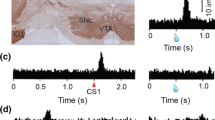Abstract
Rewards are often not only valued according to their physical characteristics but also relative to other available rewards. The striatum (caudate nucleus, putamen, ventral striatum including nucleus accumbens) is involved in the organization of movement and the processing of reward information. We studied the activity of single striatal neurons in macaques that were presented with different combinations of two rewards. We found in nearly half of the investigated neurons that the processing for one reward shifted, relative to the other rewards that were available in a given trial block. The relative reward processing concerned all forms of striatal activity related to reward-predicting visual stimuli, arm movements and reception of rewards. The observed changes may provide a neural basis for the known shifts in valuation of rewarding outcomes relative to known references.


Similar content being viewed by others
References
Bevan W (1968) The contextual basis of behavior. Am Psychol 23:701–714
Black RW (1968) Shifts in magnitude of reward and contrast effects in instrumental and selective learning: a reinterpretation. Psychol Rev 75:114–126
Bowman EM, Brown VJ (1998) Effects of excitotoxic lesions of the rat ventral striatum on the perception of reward cost. Exp Brain Res 123:439–448
Bowman EM, Aigner TG, Richmond BJ (1996) Neural signals in the monkey ventral striatum related to motivation for juice and cocaine rewards. J Neurophysiol 75:1061–1073
Brosnan SF, de Waal FBM (2003) Monkeys reject unequal pay. Nature 425:297–299
Cox WM (1975) A review of recent incentive contrast studies involving discrete-trial procedures. Psychol Rec 25:373–393
Crespi LP (1942) Quantitative variations of incentive and performance in the white rat. Am J Psychol 55:467–517
Cromwell HC, Schultz W (2003) Effects of expectations for different reward magnitudes on neuronal activity in primate striatum. J Neurophysiol 89:2823–2838
Dickinson A, Balleine B (1994) Motivational control of goal-directed action. Anim Learn Behav 22:1–18
Dorris MC, Glimcher PW (2004) Activity in posterior parietal cortex is correlated with the relative subjective desirability of action. Neuron 44:365–378
Dunham PJ (1968) Contrasted conditions of reinforcement: a selective critique. Psychol Bull 69:295–315
Flaherty CF (1996) Incentive relativity. Cambridge University Press, Cambridge
Haber S, Kunishio K, Mizobuchi M, Lynd-Balta E (1995) The orbital and medial prefrontal circuit through the primate basal ganglia. J Neurosci 15:4851–4867
Hassani OK, Cromwell HC, Schultz W (2001) Influence of expectation of different rewards on behavior-related neuronal activity in the striatum. J Neurophysiol 85:2477–2489
Hollerman JR, Tremblay L, Schultz W (1998) Influence of reward expectation on behavior-related activity in primate striatum. J Neurophysiol 80:947–963
Kahneman D, Tversky A (1984) Choices, values, and frames. Am Psychol 4:341–350
Kawagoe R, Takikawa Y, Hikosaka O (1998) Expectation of reward modulates cognitive signals in the basal ganglia. Nat Neurosci 1:411–416
Leszczuk MH, Flaherty CF (2000) Lesions of nucleus accumbens reduce instrumental but not consummatory negative contrast in rats. Behav Brain Res 116:61–79
Reynolds GS (1961) Behavioral contrast. J Exp Anal Behav 4:57–71
Salinas J, White NM (1998) Contributions of the hippocampus, amygdala and dorsal striatum to the response elicited by reward reduction. Behav Neurosci 112:812–826
Tinklepaugh OL (1928) An experimental study of representation factors in monkeys. J Comp Psychol 8:197–236
Tremblay L, Schultz W (1999) Relative reward preference in primate orbitofrontal cortex. Nature 398:704–708
Watanabe M, Hikosaka K, Sakagami M, Shirakawa SI (2002) Coding and monitoring of behavioral context in the primate prefrontal cortex. J Neurosci 22:2391–2400
Acknowledgements
We thank B. Aebischer, J. Corpataux, A. Gaillard, B. Morandi and F. Tinguely for expert technical assistance. The study was supported by the Wellcome Trust, Swiss NSF, EU Human Capital and Mobility and Biomed 2 programs via the Swiss Office of Education and Science, and US NSF (HCC).
Author information
Authors and Affiliations
Corresponding author
Rights and permissions
About this article
Cite this article
Cromwell, H.C., Hassani, O.K. & Schultz, W. Relative reward processing in primate striatum. Exp Brain Res 162, 520–525 (2005). https://doi.org/10.1007/s00221-005-2223-z
Received:
Accepted:
Published:
Issue Date:
DOI: https://doi.org/10.1007/s00221-005-2223-z




